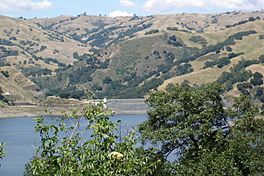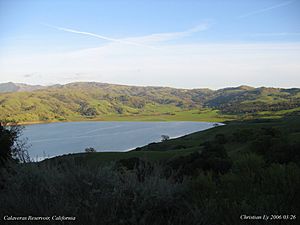Calaveras Reservoir facts for kids
Quick facts for kids Calaveras Reservoir |
|
|---|---|
 |
|
| Location | Santa Clara / Alameda counties, California, US |
| Coordinates | 37°28′43″N 121°49′21″W / 37.4785°N 121.8226°W |
| Type | Reservoir |
| Primary inflows | Arroyo Hondo Calaveras Creek |
| Catchment area | 98.4 sq mi (255 km2) |
| Basin countries | United States |
| Built | 1925 (replaced 2019) |
| Surface area | 1,450 acres (590 ha) |
| Water volume | 96,850 acre⋅ft (119,460,000 m3) (design) |
| Surface elevation | 781 feet (238 m) |
Calaveras Reservoir is a large lake located mostly in Santa Clara County, California. A smaller part of it, including its dam, is in Alameda County, California. The name "Calaveras" comes from Spanish and means "skulls."
This reservoir gets its water mainly from two creeks: Arroyo Hondo and Calaveras Creek. The area where the reservoir sits, called the Calaveras Valley, is very active geologically. This means there are earthquake faults nearby, like the Calaveras Fault. Because of the risk of earthquakes, the original dam had to be replaced. Construction on the new dam started in 2011 and was finished in 2019.
The Calaveras Valley is home to many different kinds of animals. You might see deer, coyotes, and squirrels. Many birds also live here, such as turkey vultures, red-winged blackbirds, yellow-billed magpies, red-tailed hawks, brewer's blackbirds, purple martins, barn swallows, bullock's orioles, and warblers. Since at least 2008, a pair of bald eagles has regularly built their nest here.
Contents
History of Calaveras Reservoir
In the 1800s, the Calaveras Valley, which is now covered by the reservoir, was mostly farmland. Farmers grew crops like hay, strawberries, and tomatoes. As the city of San Francisco grew, it needed more drinking water. So, around the early 1900s, farmers in the valley had to sell their land to water companies. These companies then sold the land to the San Francisco Water Company.
Building the First Dams
The first dam at this site was built in 1913 by the Spring Valley Water Company. This dam quickly changed the natural environment of the Calaveras Valley. Unfortunately, this first dam had problems with its design and materials. In 1918, the upstream side of the dam collapsed.
A new dam was built to replace it, and it stood until 2019. When it was finished in 1925, it was the largest earth-fill dam in the world. It was 245 feet (about 75 meters) high and 1200 feet (about 366 meters) long at the top. The city and county of San Francisco own and manage this dam and reservoir. They use it to supply drinking water to the city.
Why the Dam Was Replaced Again
Because of worries about earthquakes, the 1925 dam was replaced by a new one. This new dam was built just downstream from the old one between 2014 and 2019.
The reservoir is known to have many fish, including largemouth bass and rainbow trout. However, fishing is not allowed here.
The San Francisco Public Utilities Commission (SFPUC) owns a large area of land around the reservoir, about 36,000 acres (150 square kilometers). Some of this land is rented out to companies that raise cattle. This helps control plants and prevent fires. Most of the land is closed to the public. This is done to keep the drinking water safe and clean.
Replacing the Dam for Safety
The area around the dam has an active earthquake fault nearby. The original 1925 dam was not strong enough to withstand a major earthquake. If the dam had broken when it was full, it could have flooded parts of Fremont, California. The water could have been as high as 30 feet (9 meters). Because of this risk, state regulators limited how much water the old dam could hold in 2001. Its capacity was reduced to about one-third of its original amount.
To get back the lost water storage, the San Francisco Public Utilities Commission built a new dam. This new dam is located about 1000 feet (305 meters) downstream from the old 1925 dam. Building the new dam took longer and cost more than planned. It took eight years instead of four, and the cost doubled. This was because workers found old landslides and other difficult ground conditions near the dam site.
The new dam was designed so that it could be made even taller in the future. Its core is wider than needed right now. This design allows the dam's height to be raised by 150 feet (46 meters). If this happens, the reservoir's capacity could become four times larger than its current 100,000 acre-feet (120 million cubic meters). After the new dam was finished, part of the old dam was removed. This allowed the new dam to hold back the reservoir's water.
The construction project also set aside money to help native fish populations in other parts of the watershed. Building a fish ladder for Steelhead trout at the dam itself was not possible. It would have been too tall and too expensive. However, the SFPUC promised to release water from the new dam to help improve water flow in the summer. A smaller fish ladder is being built at a different dam on upper Alameda Creek, which is a good place for trout.
Wildlife and Water Flow
The San Francisco Public Utilities Commission (SFPUC) now releases water steadily from the dam. They started doing this after the dam was rebuilt in 2018. This helps support steelhead trout (Oncorhynchus mykiss) in the 20 miles (32 kilometers) of Calaveras Creek below the dam. These steady water releases and cooler water temperatures have led to a big increase in the number of trout.
Plane Crash Discovery
In the late 1980s and early 1990s, California had a severe drought. Water levels in reservoirs across the state became very low. By January 1991, the water in Calaveras Reservoir was down by 100 feet (30 meters). At this low level, the metal body of an airplane became visible.
On January 5, 1991, two skeletons were found at the crash site. Using dental records and the plane's serial number, officials identified the remains. They belonged to Clifford Gillman and his friend Robert Louviere. Their single-engine Ercoupe plane had been missing since June 16, 1963. The plane's wreckage, without the remains, is still at the bottom of the reservoir.
Images for kids








